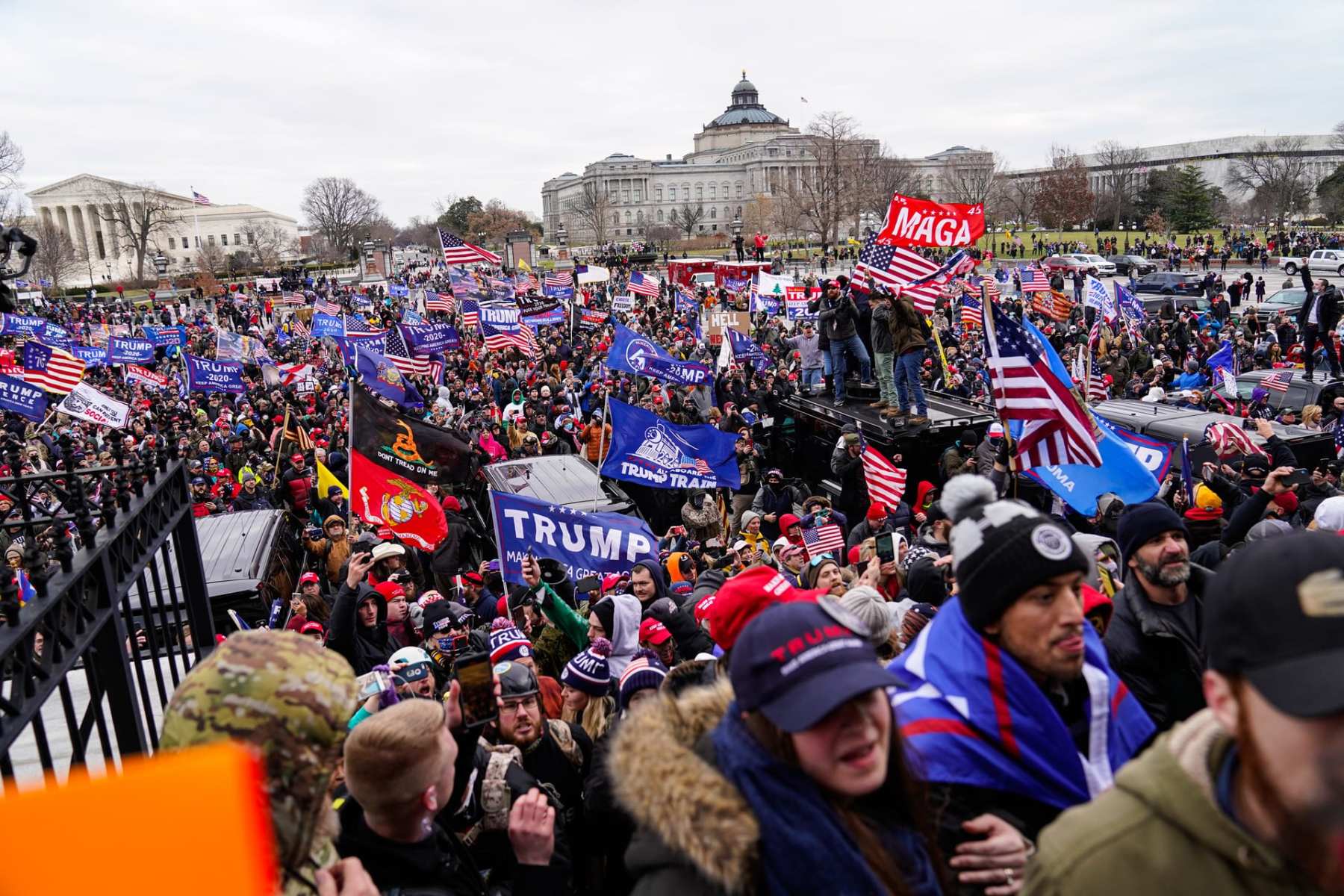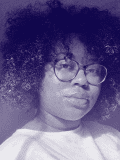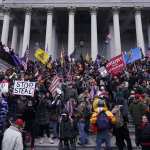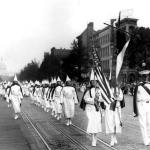“We’re going to the Capitol,” President Donald Trump told supporters. During a speech at Wednesday’s “Save America” rally, Trump claimed, as he has done many times, that the 2020 election had been stolen and he would never concede. After the president spoke for more than an hour, thousands of his supporters formed a mob and descended on Capitol Hill as Congress met to certify President-elect Joe Biden’s win. They breached security, scaled walls and broke windows as Trump continued to promote false claims of a rigged election via Twitter, which permanently suspended the president Friday.
And most of them, it seemed, were White men. Many of the images and videos that have emerged from the Capitol on Wednesday show large swathes of White men outside and inside of the Capitol, carrying Gadsden flags, Trump flags, American flags, Confederate flags, thin-blue-line flags. In one of the most circulated photos from the riots, a White man is seen with his feet on the desk in House Speaker Nancy Pelosi’s office. He later told a New York Times reporter that he left a note letting the “bitch” know he had been there. He has since been arrested.
The insurrection is largely being characterized as being fueled by a particularly masculine brand of white supremacy. But White women have long had a place in extremism, said Seyward Darby, author of “Sisters in Hate: American Women on the Front Lines of White Nationalism.” Throughout history, White women have served extremist movements like the Ku Klux Klan and remain a “sustaining feature” of white nationalism, Darby writes in her book. But women, who are often pigeonholed as delicate or nurturing, are often not recognized in their roles in extremist movements.
“We need to reckon with the fact that we should not be surprised — women are full and complex human beings, which means they’re also capable of really bad shit,” Darby told The 19th. “They’re not above the fray; sometimes they’re down in it.”
As evidenced on Wednesday, some women are willing to go to extremes to protect the outgoing president.
Five people have died as a result of the insurrection, including a Capitol Police officer. Two of them were women. Ashli Babbitt, a 35-year-old Air Force veteran, succumbed to gunshot wounds Wednesday evening. Babbitt was captured on video on the frontlines of rioters who rushed the doors leading to the Speaker’s Lobby, which leads to the House chamber. With a Trump flag strewn over her backpack, she tried to jump through a shattered doorway as a police officer fired at her, according to The Washington Post.
A 34-year-old woman named Rosanne Boyland, who had traveled from Georgia to attend the rally, was trampled to death in the riot. Details of her death are still emerging. Both Babbitt and Boyland are reported to have followed QAnon, a prolific far-right conspiracy theory. Experts identified promoters of QAnon at the Capitol on Wednesday.
Darby began researching women who support white nationalism right after the 2016 election, when more than half of White women voted to send Trump to the White House. There was significantly more coverage of the Women’s March on Washington, she noted, and near radio silence about the women on the far-right.
“I think there’s this idea that White women are somehow going to be disgusted by what they’re seeing as opposed to being swept up in the extremism of it all, or at least willing to tolerate it,” she said.
Many expected Trump’s increasingly controversial rhetoric to push conservative women across party lines, particularly in the 2020 election. Darby wondered why. A majority of White women have not voted for a Democratic presidential nominee since 1996 — before that, it was 1964. Most of these women aren’t involved in hate groups or extremism, but Darby references voting data because race continues to be the biggest predictor in political party allegiances, irrespective of gender. The majority of White women backed the president again in 2020, according to initial exit polling.
In her book, published last July, Darby follows three notable far-right figures with huge internet followings to examine the breadth and depth of women’s participation in nationalism as the president pushed such ideals into the mainstream.
Whether it was whisper networks the Women of the Ku Klux Klan used to disseminate hate speech when the group formed on the heels of the 19th Amendment or present-day “mommy bloggers” and social media influencers, White women have been some of the most successful propagandists in extremist movements. As sociologist Kathleen Blee, one of the leading researchers on gender and hate, noted in her book “Women of the Klan: Racism and Gender in the 1920s,” the women’s Klan was more effective in carrying out the racist politics than the men, using gossip to collapse Jewish grocery stores, run African Americans in White communities out of town and push teachers who practiced Catholicism out of their districts.
Women’s effectiveness in such circles often hinges on gender stereotypes. One of the subjects in Darby’s book said at a white nationalist conference in 2017 that women can get away with saying big things because they aren’t as physically intimidating.
“Women are the hate movement’s dulcet voices and its standard bearers,” Darby writes. “As purveyors and keepers and caretakers, they arguably tap into a wider spectrum of power than men do…”
People outside of these movements discount or overlook women in white nationalism at America’s peril, Darby writes, while also minimizing or ignoring the factors that push them into these movements. For Darby, it’s “thorny” to identify why women organize among misogynist, far-right extremist groups. Some are disenchanted with contemporary feminism, and see preserving white supremacy as the solution to problems of both the personal and political sort. “What about women who benefit — or want to benefit — from existing structures of dominance?” Darby asks. “We risk stripping them of responsibility when we suggest that the harm they do is merely a way of coping with their own oppression, whether real or presumed.”
Darby noted that often, extremism and misogyny can go hand-in-hand, with groups espousing sexist views or, in the case of the Proud Boys — self-identified “western chauvinists,” who have been designated by the FBI in 2018 as extremists with ties to white nationalism — shutting out women entirely.
The night before Congress convened to certify election results, Proud Boys clashed with police officers in Washington, D.C. Their leader was banned from D.C. days before the rally preceding the insurrection, and through photos, experts have identified members of the Proud Boys at the Capitol riot.
But there is still an appeal to White women: These spaces also espouse women as beautiful protectors of the race’s future. For anyone looking to feel valued, these movements can be very seductive, Darby said.
“Yes, these spaces are absolutely horrible to women,” Darby said. “But there are ways in which they’re also appealing to women and making it easy for them to feel like they matter.”
Because of that symbolism, Darby is worried about Babbitt’s death inciting further action (Boyland had not been identified at the time The 19th interviewed Darby).
“I don’t think [Babbitt] should have died, I don’t think the police should be shooting anybody,” Darby said. “But what worries me is all of the things that she represents. Because she actually now can kind of be turned into a symbol that the Proud Boy types very much respond to and groups like them have responded to over time: This idea of a White American woman who was sacrificed for the good of the people and the Republic, and whiteness.”
Cassie Miller, a senior research analyst for Southern Poverty Law Center’s Intelligence Project, said that while women may not be the face of these movements, they’re still playing crucial roles through organizing and disseminating messaging. But they also act as a symbol of subservience to the patriarchy. Miller noted that a tenet of the Proud Boys — which the Southern Poverty Law Center has designated a hate group — is “venerate the housewife.”
“Within these movements, women are mostly valued for their reproductive capabilities, and for their roles as mothers, and they are meant to be protected,” Miller said. “And so the fact that a woman died [Wednesday] I think is very significant, because she was seen as particularly vulnerable.”
The Proud Boys are a prime example of the face of extremism taking on a distinctly masculine tone: One of the primary qualifications of membership is being a man. The group’s bylaws require men to undergo violent initiation including physical beatings or a “material sacrifice or service” in some cases, including getting arrested or committing an act of violence, according to a lawsuit filed against the group.
Members of the Proud Boys were at the 2017 white supremacist Unite the Right rally in Charlottesville where activist Heather Heyer was killed and dozens severely injured. “You had some very bad people in that group, but you also had people that were very fine people, on both sides,” Trump said afterwards.
At the first presidential debate in September 2020, Trump refused to condemn white supremacy, and instead told the Proud Boys to “stand back and stand by.”
The Lawyers Committee for Civil Rights Under Law filed a lawsuit on January 4 against the Proud Boys and its chairman, Henry “Enrique” Tarrio, for targeting a historic Black church during a December rally-turned-riot in support of Trump, stealing and damaging its Black Lives Matter sign. The lawsuit says Tarrio boasted on his Parler account, a social media app where many far-right extremists gather, that he burned a Black Lives Matter banner stolen from another historic Black church in Washington, D.C., last month. The same day the lawsuit was filed, Tarrio was arrested in D.C. and charged with destruction of property. Tarrio has since been released, but a local judge ordered him to stay out of the nation’s capital until his next court appearance in June.
“We filed this lawsuit because we wanted to send a warning to other individuals who might be considering engaging in this type of violent, racist attack,” said Arusha Gordon, an attorney specializing in hate crimes for the Lawyers Committee for Civil Rights Under Law.
The lawsuit also detailed the Proud Boys’ public plans to descend on D.C. this week. “Big protest in D.C. on January 6th,” Trump tweeted in December. “Be there, will be wild!”
Gordon said she was frustrated to see law enforcement at the Capitol underestimate what white supremacist violence can do. The head of Capitol Police has since resigned, and the Associated Press reported that the Capitol Police rejected federal help ahead of January 6 and during the actual riots. The degree of privilege and impunity the mob felt, Gordon said, was evidenced by the fact that many didn’t hide their faces as they damaged the Capitol.
Before the insurrection, the Proud Boys had already been planning to return to D.C. to interrupt the inauguration on January 20, when Vice President-elect Kamala Harris will become the first Black woman sworn into the White House.
“You show up there in Biden gear and you turn his inauguration into a fucking circus, a sign of resistance, a sign of revolution,” Tarrio said in November. “You fucking kick off this presidency with fucking fireworks.”






